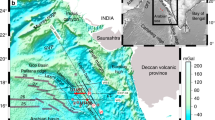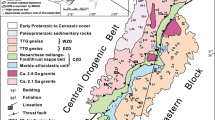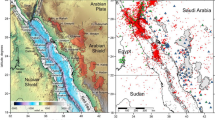Abstract
Continental breakup represents the successful process of rifting and thinning of the continental lithosphere, leading to plate rupture and initiation of oceanic crust formation. Magmatism during breakup seems to follow a path of either excessive, transient magmatism (magma-rich margins) or of igneous starvation (magma-poor margins). The latter type is characterized by extreme continental lithospheric extension and mantle exhumation prior to igneous oceanic crust formation. Discovery of magma-poor margins has raised fundamental questions about the onset of ocean-floor type magmatism, and has guided interpretation of seismic data across many rifted margins, including the highly extended northern South China Sea margin. Here we report International Ocean Discovery Program drilling data from the northern South China Sea margin, testing the magma-poor margin model outside the North Atlantic. Contrary to expectations, results show initiation of Mid-Ocean Ridge basalt type magmatism during breakup, with a narrow and rapid transition into igneous oceanic crust. Coring and seismic data suggest that fast lithospheric extension without mantle exhumation generated a margin structure between the two endmembers. Asthenospheric upwelling yielding Mid-Ocean Ridge basalt-type magmatism from normal-temperature mantle during final breakup is interpreted to reflect rapid rifting within thin pre-rift lithosphere.
This is a preview of subscription content, access via your institution
Access options
Access Nature and 54 other Nature Portfolio journals
Get Nature+, our best-value online-access subscription
$29.99 / 30 days
cancel any time
Subscribe to this journal
Receive 12 print issues and online access
$259.00 per year
only $21.58 per issue
Buy this article
- Purchase on Springer Link
- Instant access to full article PDF
Prices may be subject to local taxes which are calculated during checkout




Similar content being viewed by others
References
Peron-Pinvidic, G., Manatschal, G. & Osmundsen, P. T. Structural comparison of archetypal Atlantic rifted margins: a review of observations and concepts. Mar. Pet. Geol. 43, 21–47 (2013).
Tugend, J. et al. Reappraisal of the Magma-Rich versus Magma-Poor Rifted Margin Archetypes Spec. Pub. SP476.9 (Geological Society of London, 2018); https://doi.org/10.1144/SP476.9
Franke, D. Rifting, lithosphere breakup and volcanism: comparison of magma-poor and volcanic rifted margins. Mar. Pet. Geol. 43, 63–87 (2013).
Gao, J. et al. The continent–ocean transition at the mid-northern margin of the South China Sea. Tectonophysics 654, 1–19 (2015).
Lester, R. et al. Rifting and magmatism in the northeastern South China Sea from wide-angle tomography and seismic reflection imaging. J. Geophys. Res. Solid Earth 119, 2305–2323 (2014).
Holbrook, W. S. et al. Mantle thermal structure and active upwelling during continental breakup in the North Atlantic. Earth Planet. Sci. Lett. 190, 251–266 (2001).
Larsen, H. C. & Saunders, A. D. Tectonism and volcanism at the southeast greenland rifted margin: a record of plume impact and later continental rupture. In Proc. ODP Sci. Res. (eds Saunders, A. D., Larsen, L. C. & Wise, S. W. Jr) Vol. 152, Ch. 41 (ODP, 1998); https://doi.org/10.2973/odp.proc.sr.152.240.1998
Boillot, G., Winterer, E. L. & Al, E. Drilling on the galicia margin: retrospect and prospect. In Proc. ODP Sci. Res. (eds Boillot, G., Winterer, E. L. & Meyer, A. W.) Vol. 103, Ch. 45 (ODP, 1988); https://doi.org/10.2973/odp.proc.sr.103.180.1988
Minshull, T. A. Geophysical characterisation of the ocean–continent transition at magma-poor rifted margins. Comptes Rendus Geosci. 341, 382–393 (2009).
Tucholke, B. & Sibuet, J.-C. Leg 210 synthesis: tectonic, magmatic, and sedimentary evolution of the newfoundland-iberia rift. In Proc. ODP Sci. Res. (eds Tucholke, B.E., Sibuet, J.-C. & Klaus, A) Vol. 210, Ch. 1 (ODP, 2007); https://doi.org/10.2973/odp.proc.sr.210.101.2007
Whitmarsh, R. B., Manatschal, G. & Minshull, T. A. Evolution of magma-poor continental margins from rifting to seafloor spreading. Nature 413, 150–154 (2001).
Lizarralde, D. et al. Variation in styles of rifting in the Gulf of California. Nature 448, 466–469 (2007).
Ligi, M. et al. Birth of an ocean in the Red Sea: initial pangs. Geochem. Geophys. Geosyst. 13, Q08009 (2012).
Li, C.-F., Lin, J., Kulhanek, D. K. & Expedition 349 Scientists. Expedition 349 summary. In Proc. IODP (eds Li, C.-F., Lin, J., Kulhanek, D. K. & Expedition 349 Scientists) Vol. 349, Ch. 1 (IODP, 2015); https://doi.org/10.14379/iodp.proc.349.101.2015
Taylor, B. & Hayes, D. Origin and history of the South China Sea basin. Tecton. Geol. Evol. 27, 23–56 (1983).
Sun, Z. et al. Expedition 367/368 Scientific Prospectus: South China Sea Rifted Margin 39–106 (IODP, 2016); https://doi.org/10.14379/iodp.sp.367368.2016
Zhou, D., Ru, K. & Chen, H. Kinematics of Cenozoic extension on the South China Sea continental margin and its implications for the tectonic evolution of the region. Tectonophysics 251, 161–177 (1995).
Ru, K. & Pigott, J. D. Episodic rifting and subsidence in the South China Sea. Am. Assoc. Pet. Geol. Bull. 70, 1136–1155 (1986).
Franke et al. The final rifting evolution in the South China Sea. Mar. Pet. Geol. 58, 704–720 (2014).
Franke, D. et al. The continent-ocean transition at the southeastern margin of the South China Sea. Mar. Pet. Geol. 28, 1187–1204 (2011).
Fan, C. et al. New insights into the magmatism in the northern margin of the South China Sea: spatial features and volume of intraplate seamounts. Geochem. Geophys. Geosyst. 18, 2216–2239 (2017).
Zhao, F. et al. Prolonged post-rift magmatism on highly extended crust of divergent continental margins (Baiyun Sag, South China Sea). Earth Planet. Sci. Lett. 445, 79–91 (2016).
Brune, S., Heine, C., Clift, P. D. & Pérez-Gussinyé, M. Rifted margin architecture and crustal rheology: reviewing Iberia–Newfoundland, Central South Atlantic, and South China Sea. Mar. Pet. Geol. 79, 257–281 (2017).
Clift, P., Lin, J. & Barckhausen, U. Evidence of low flexural rigidity and low viscosity lower continental crust during continental break-up in the South China Sea. Mar. Pet. Geol. 19, 951–970 (2002).
Clift, P. D., Brune, S. & Quinteros, J. Climate changes control offshore crustal structure at South China Sea continental margin. Earth Planet. Sci. Lett. 420, 66–72 (2015).
Briais, A., Patriat, P. & Tapponnier, P. Updated interpretation of magnetic anomalies and seafloor spreading stages in the south China Sea: implications for the Tertiary tectonics of Southeast Asia. J. Geophys. Res. 98, 6299 (1993).
Li, C.-F. et al. Ages and magnetic structures of the South China Sea constrained by deep tow magnetic surveys and IODP Expedition 349. Geochem. Geophys. Geosyst. 15, 4958–4983 (2014).
Pin, Y., Di, Z. & Zhaoshu, L. A crustal structure pro file across the northern continental margin of the South China Sea. Tectonophysics 338, 1–21 (2001).
Larsen, H. C. et al. Site U1501. In Proc. IODP (eds Sun, Z. et al.) Vol. 367/368, Ch. 5 (IODP, 2018); https://doi.org/10.14379/iodp.proc.367368.105.2018
Pinglu, L. & Chuntao, R. Tectonic characteristics and evolution history of the Pearl river mouth basin. Tectonophysics 235, 13–25 (1994).
Li, C.-F., Lin, J., Kulhanek, D. K. & Expedition 349 Scientists. Site U1435. In Proc. IODP (eds Li, C.-F., Lin, J., Kulhanek, D. K. & Expedition 349 Scientists) Vol. 349, Ch. 7 (IODP, 2015); https://doi.org/10.14379/iodp.proc.349.107.2015
Sun, Z. et al. Site U1499. In Proc. IODP (eds Sun, Z. et al.) Vol. 367/368, Ch. 3 (IODP, 2018); https://doi.org/10.14379/iodp.proc.367368.103.2018
Larsen, H. C. et al. Site U1502. In Proc. IODP (eds Sun, Z. et al.) Vol. 367/368, Ch. 6 (IODP, 2018); https://doi.org/10.14379/iodp.proc.367368.106.2018
Stock, J. M. et al. Site U1500. In Proc. IODP (eds Sun, Z. et al.) Vol. 367/368, Ch. 4 (IODP, 2018); https://doi.org/10.14379/iodp.proc.367368.104.2018
Minshull, T. A., Dean, S. M., White, R. S. & Whitmarsh, R. B. Anomalous melt production after continental break-up in the southern Iberia Abyssal Plain. Geol. Soc. Lond., Spec. Publ. 187, 537–550 (2001).
Mohn, G., Karner, G. D., Manatschal, G. & Johnson, C. A. Structural and stratigraphic evolution of the Iberia–Newfoundland hyper-extended rifted margin: a quantitative modelling approach. Geol. Soc. Lond. Spec. Pub. 413, 53–89 (2015).
White, R. & McKenzie, D. Magmatism at rift zones: the generation of volcanic continental margins and flood basalts. J. Geophys. Res. 94, 7685 (1989).
Fletcher, R., Kusznir, N. & Cheadle, M. Melt initiation and mantle exhumation at the Iberian rifted margin: comparison of pure-shear and upwelling-divergent flow models of continental breakup. Comptes Rendus Geosci. 341, 394–405 (2009).
Mckenzie, D. & Bickle, M. J. The volume and composition of melt generated by extension of the lithosphere. J. Petrol. 29, 625–679 (1988).
Bown, J. W. & White, R. S. Effect of finite extension rate on melt generation at rifted continental margins. J. Geophys. Res. Solid Earth 100, 18011–18029 (1995).
Lizarralde, D., Gaherty, J. B., Collins, J. A., Hirth, G. & Kim, S. D. Spreading-rate dependence of melt extraction at mid-ocean ridges from mantle seismic refraction data. Nature 432, 744–747 (2004).
Yu, C. et al. Deep thermal structure of Southeast Asia constrained by S-velocity data. Mar. Geophys. Res. 38, 341–355 (2017).
Sotin, C. & Parmentier, E. M. Dynamical consequences of compositional and thermal density stratification beneath spreading centers. Geophys. Res. Lett. 16, 835–838 (1989).
McKenzie, D. P. The generation and compaction of partial melts. J. Petrol. 25, 713–765 (1984).
Ohuchi, T. et al. Dislocation-accommodated grain boundary sliding as the major deformation mechanism of olivine in the Earth’s upper mantle. Sci. Adv. 1, e1500360 (2015).
Huismans, R. & Beaumont, C. Depth-dependent extension, two-stage breakup and cratonic underplating at rifted margins. Nature 473, 74–78 (2011).
Nissen, S. S. et al. Gravity, heat flow, and seismic constraints on the processes of crustal extension: northern margin of the South China Sea. J. Geophys. Res. 100, 22447 (1995).
Gradstein, F. M. & Ogg, J. G. in The Geologic Time Scale (eds Gradstein, F. M., Ogg, J. G., Schmitz, M. D. & Ogg, G. M.) Ch. 2, 31–42 (Elsevier, Amsterdam, 2012).
Amante, C. & Eakins, B. W. ETOPO1 1 Arc-Minute Global Relief Model: Procedures, Data Sources and Analysis NOAA Tech. Memo NESDIS NGDC-24 (National Geophysical Data Center, NOAA, 2009); https://doi.org/10.1594/PANGAEA.769615
Wang, P., Prell, W. L. & Blum, P. (eds) in Proc. ODP, Init. Repts Vol. 184, Ch. 1 (ODP, 2000).
Larsen, H. C. et al. Expedition 367/368 summary. In Proc. IODP (eds Sun, Z. et al.) Vol. 367/368, Ch. 1 (IODP, 2018); https://doi.org/10.14379/iodp.proc.367368.101.2018
Seton, M. et al. Community infrastructure and repository for marine magnetic identifications. Geochem. Geophys. Geosyst. 15, 1629–1641 (2014).
Gee, J. S. & Kent, D. V. Source of oceanic magnetic anomalies and the geomagnetic polarity timescale. Treatise Geophys. 5, 455–507 (2007).
Ishihara, T. & Kisimoto, K. Magnetic Anomaly Map of East Asia 1:4.000.000, CD-ROM (Geological survey of Japan, 1996).
Dai, Y. et al. Threshold conditions and reservoir-controlling characteristics of source kitchen in Zhu I depression, Pearl River Mouth Basin. Acta Pet. Sin. 36, 145–155 (2015).
Shi, H., He, M. & Zhang, L. Hydrocarbon geology, accumulation pattern and the next exploration strategy in the eastern Pearl River Mouth basin. China Offshore Oil Gas. 26, 11–22 (2014).
Shervais, J. W. Ti–V plots and the petrogenesis of modern and ophiolitic lavas. Earth Planet. Sci. Lett. 59, 101–118 (1982).
Sun, Z. et al. Methods. In Proc IODP (eds Sun, Z. et al.) Vol. 367/368, Ch. 2 (IODP, 2018); https://doi.org/10.14379/iodp.proc.367368.102.2018
Acknowledgements
The authors acknowledge the Chinese National Offshore Oil and Gas Company (CNOOC) for providing access for Z.S. and H.C.L. to work on their large regional database of seismic reflection data, which CNOOC subsequently amended with acquisition of new data to document our selected drill sites. The authors thank the RV JOIDES Resolution crew and the IODP technical staff. The IODP–China office supported international workshops to develop the original drilling proposal. Co-principal investigators of the drilling proposal, P. Wang and C.-F. Li, are acknowledged for their contributions to planning. This research used data and samples provided by the International Ocean Discovery Program. A.K. and C.A.-Z. acknowledge support from NSF award no. OCE-1326927. D.Z. was supported by the Korean IODP program (KIODP).
Author information
Authors and Affiliations
Contributions
H.C.L. was co-principal investigator (co-PI) for the original drilling proposal and interpretation of seismic data, co-chief scientist of expeditions 367/368, and directed the writing of the paper. G.M. is principal co-author, developed the geodynamic model jointly with H.C.L. and M.N. and was a shipboard scientist (structural geology) at expedition 368. M.N. was a shipboard scientist (structure/sedimentology) at expedition 367, carried out structural interpretation of syn-rift sedimentation, and contributed to model development and graphics. Z.S was co-PI for the original drilling proposal, interpretation of seismic data, and was co-chief scientist of expeditions 367/368. J.S. was co-chief scientist of expeditions 367/368 and co-proponent of the original drilling proposal. Z.J. was co-chief scientist of expeditions 367/368 and coordinated biostratigraphic interpretations. A.K. was expeditions 367/368 project manager. C.A.A.-Z. was expeditions 367/368 project manager and performed biostratigraphy. J.B., A.B., Y.C., M.D., A.F., J.H., T.W.H., K.H., B.H., X.H., B.J., C.Lei., L.L., Z.L., A.L., C.Lupi, A.McC., M.N., C.R., I.S., C.S., X.S., R.X., R.Y., L.Y., C.Z., J.Z., Y.Z., N.Z. and L.Z. collected the drilling data during IODP expedition 367 and participated in the writing of the paper. S.B., D.C., K.D., W.D., E.F., F.F., A.G., E.H., S.J., H.J., R.K., B.L., Y.L., J.L. (co-PI)., Chang Liu, Chuanlian Liu, L.N., N.O., D.W.P., P.P., N.Q., S.Sa., J.C.S., S.St., L.T., F.M.vdZ., S.W., H.W., P.S.Y. and G.Z. collected the drilling data during IODP expedition 368 and participated in writing of the paper. Roles on board are detailed in https://iodp.tamu.edu/scienceops/precruise/southchinasea2/participants.html.
Corresponding authors
Ethics declarations
Competing interests
The authors declare no competing interests.
Additional information
Publisher’s note: Springer Nature remains neutral with regard to jurisdictional claims in published maps and institutional affiliations.
Supplementary information
Rights and permissions
About this article
Cite this article
Larsen, H.C., Mohn, G., Nirrengarten, M. et al. Rapid transition from continental breakup to igneous oceanic crust in the South China Sea. Nature Geosci 11, 782–789 (2018). https://doi.org/10.1038/s41561-018-0198-1
Received:
Accepted:
Published:
Issue Date:
DOI: https://doi.org/10.1038/s41561-018-0198-1
This article is cited by
-
Towards a process-based understanding of rifted continental margins
Nature Reviews Earth & Environment (2023)
-
Architecture of Eastern Mediterranean sea rifted margins: observations and uncertainties on their Mesozoic evolution
International Journal of Earth Sciences (2023)
-
Rock physics diagnostics to characterize early diagenetic processes in hemipelagic calcareous ooze in the northern South China Sea margin
Marine Geophysical Research (2023)
-
Gravity modelling of crustal architecture and heterogeneity in the Nansha Block, South China Sea
Journal of Oceanology and Limnology (2023)
-
Cenozoic Propagated Rifting in the Dangerous Grounds in Response to the Episodic Seafloor Spreading of the South China Sea
Journal of Earth Science (2022)




